Essay: Comparing Perception Theories of Melzoff, Borton, and Piaget
VerifiedAdded on 2022/08/15
|6
|1446
|11
Essay
AI Summary
This essay delves into the realm of perception, comparing and contrasting the theories of Melzoff and Borton with those of Piaget. It begins by introducing the concept of perception as the interpretation of sensory information, highlighting the roles of bottom-up and top-down processing. The essay then explores Melzoff and Borton's research on intermodal matching in neonates, focusing on their hypotheses and findings regarding the ability of infants to differentiate shapes through touch and correlate visual perception. Subsequently, it examines Piaget's theory of cognitive development, particularly the sensorimotor stage, and how children develop mental models of the world through interaction and maturation. The core of the essay lies in the comparison of these two perspectives, noting how Melzoff and Borton's findings challenge Piaget's assertion that infants begin with independent sense modalities, suggesting instead an innate capacity for intermodal perception. The essay concludes by emphasizing the importance of perception in guiding actions and decisions as infants develop, and the contrasting views on the origins of this ability.
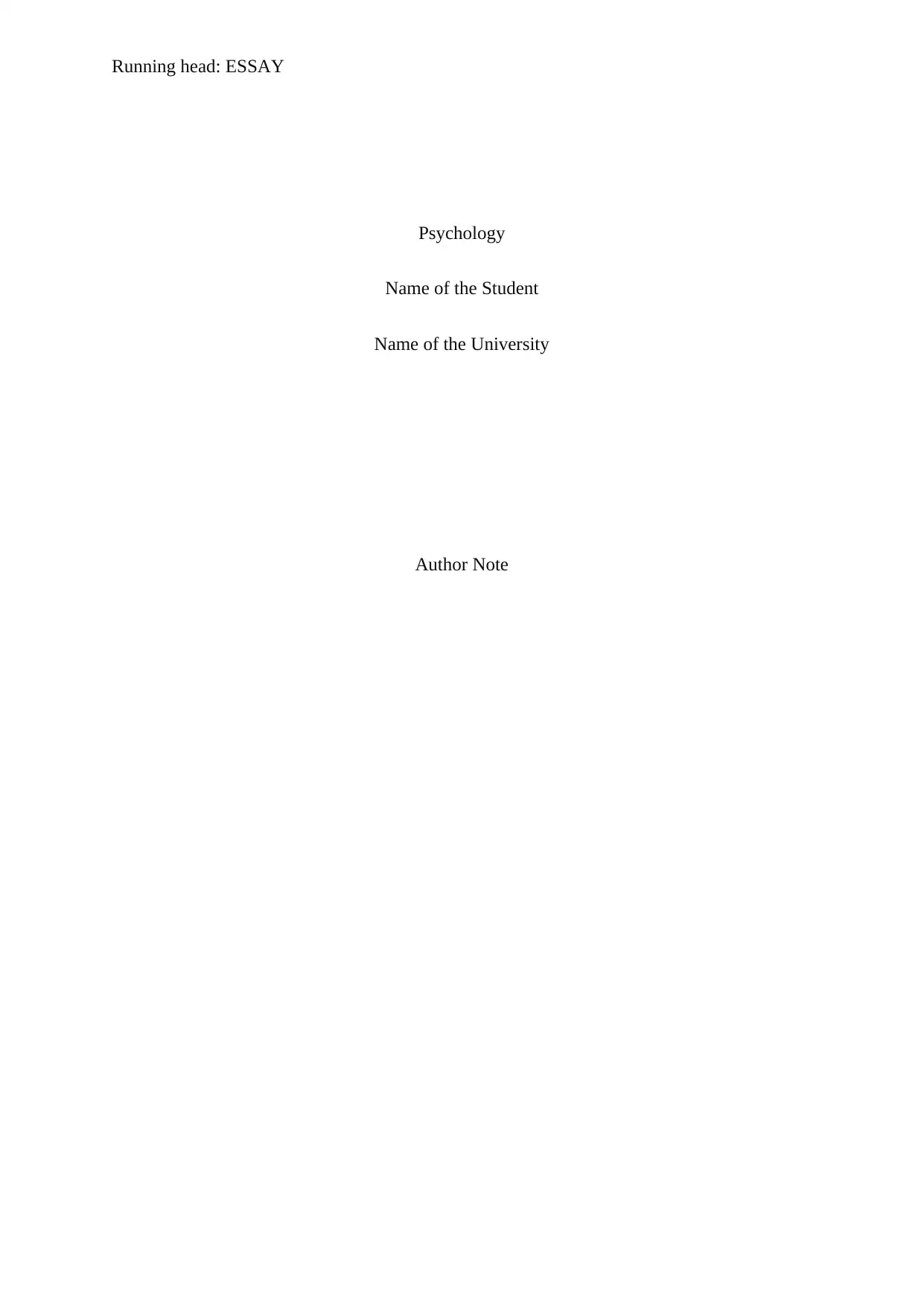
Running head: ESSAY
Psychology
Name of the Student
Name of the University
Author Note
Psychology
Name of the Student
Name of the University
Author Note
Paraphrase This Document
Need a fresh take? Get an instant paraphrase of this document with our AI Paraphraser
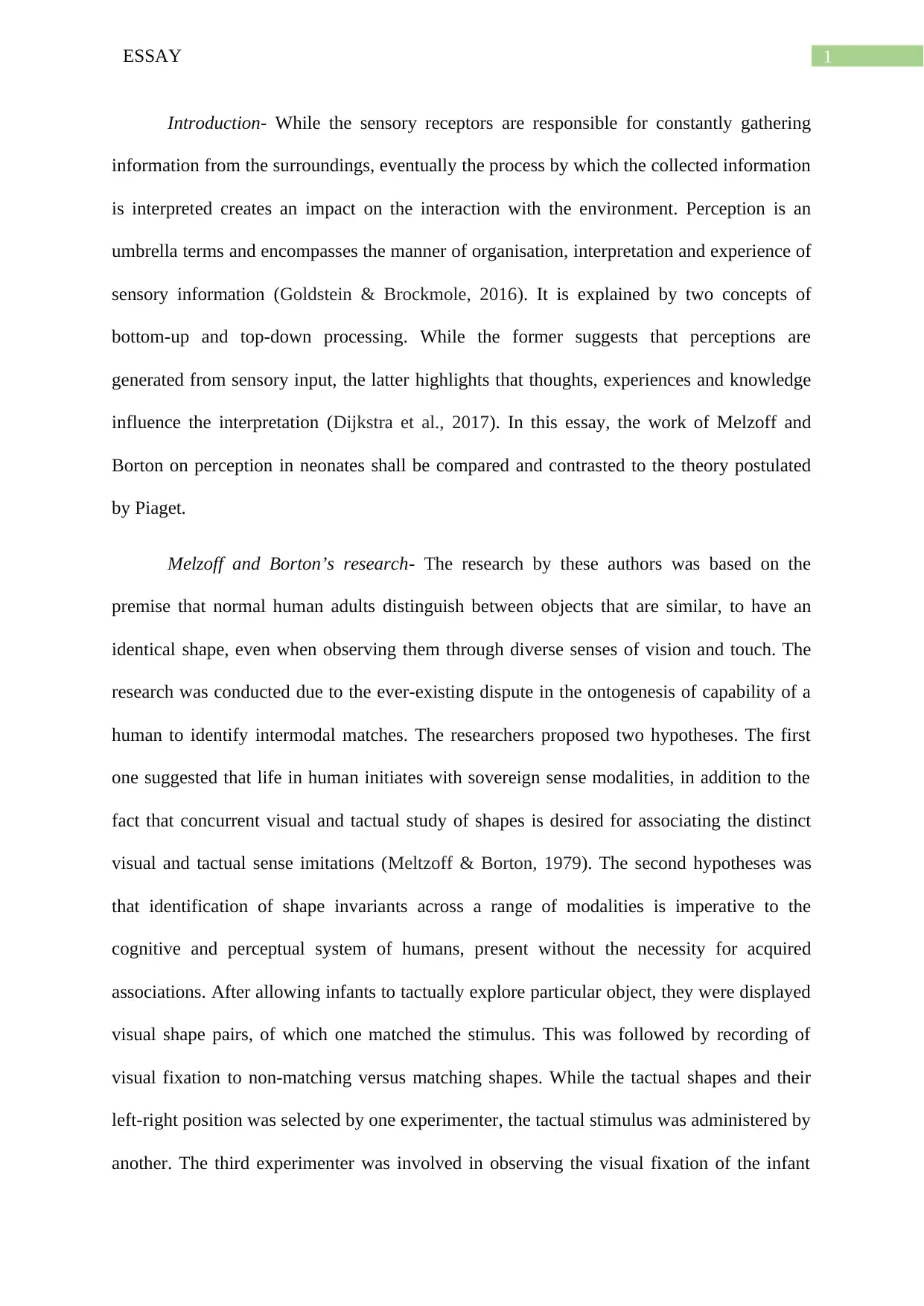
1ESSAY
Introduction- While the sensory receptors are responsible for constantly gathering
information from the surroundings, eventually the process by which the collected information
is interpreted creates an impact on the interaction with the environment. Perception is an
umbrella terms and encompasses the manner of organisation, interpretation and experience of
sensory information (Goldstein & Brockmole, 2016). It is explained by two concepts of
bottom-up and top-down processing. While the former suggests that perceptions are
generated from sensory input, the latter highlights that thoughts, experiences and knowledge
influence the interpretation (Dijkstra et al., 2017). In this essay, the work of Melzoff and
Borton on perception in neonates shall be compared and contrasted to the theory postulated
by Piaget.
Melzoff and Borton’s research- The research by these authors was based on the
premise that normal human adults distinguish between objects that are similar, to have an
identical shape, even when observing them through diverse senses of vision and touch. The
research was conducted due to the ever-existing dispute in the ontogenesis of capability of a
human to identify intermodal matches. The researchers proposed two hypotheses. The first
one suggested that life in human initiates with sovereign sense modalities, in addition to the
fact that concurrent visual and tactual study of shapes is desired for associating the distinct
visual and tactual sense imitations (Meltzoff & Borton, 1979). The second hypotheses was
that identification of shape invariants across a range of modalities is imperative to the
cognitive and perceptual system of humans, present without the necessity for acquired
associations. After allowing infants to tactually explore particular object, they were displayed
visual shape pairs, of which one matched the stimulus. This was followed by recording of
visual fixation to non-matching versus matching shapes. While the tactual shapes and their
left-right position was selected by one experimenter, the tactual stimulus was administered by
another. The third experimenter was involved in observing the visual fixation of the infant
Introduction- While the sensory receptors are responsible for constantly gathering
information from the surroundings, eventually the process by which the collected information
is interpreted creates an impact on the interaction with the environment. Perception is an
umbrella terms and encompasses the manner of organisation, interpretation and experience of
sensory information (Goldstein & Brockmole, 2016). It is explained by two concepts of
bottom-up and top-down processing. While the former suggests that perceptions are
generated from sensory input, the latter highlights that thoughts, experiences and knowledge
influence the interpretation (Dijkstra et al., 2017). In this essay, the work of Melzoff and
Borton on perception in neonates shall be compared and contrasted to the theory postulated
by Piaget.
Melzoff and Borton’s research- The research by these authors was based on the
premise that normal human adults distinguish between objects that are similar, to have an
identical shape, even when observing them through diverse senses of vision and touch. The
research was conducted due to the ever-existing dispute in the ontogenesis of capability of a
human to identify intermodal matches. The researchers proposed two hypotheses. The first
one suggested that life in human initiates with sovereign sense modalities, in addition to the
fact that concurrent visual and tactual study of shapes is desired for associating the distinct
visual and tactual sense imitations (Meltzoff & Borton, 1979). The second hypotheses was
that identification of shape invariants across a range of modalities is imperative to the
cognitive and perceptual system of humans, present without the necessity for acquired
associations. After allowing infants to tactually explore particular object, they were displayed
visual shape pairs, of which one matched the stimulus. This was followed by recording of
visual fixation to non-matching versus matching shapes. While the tactual shapes and their
left-right position was selected by one experimenter, the tactual stimulus was administered by
another. The third experimenter was involved in observing the visual fixation of the infant
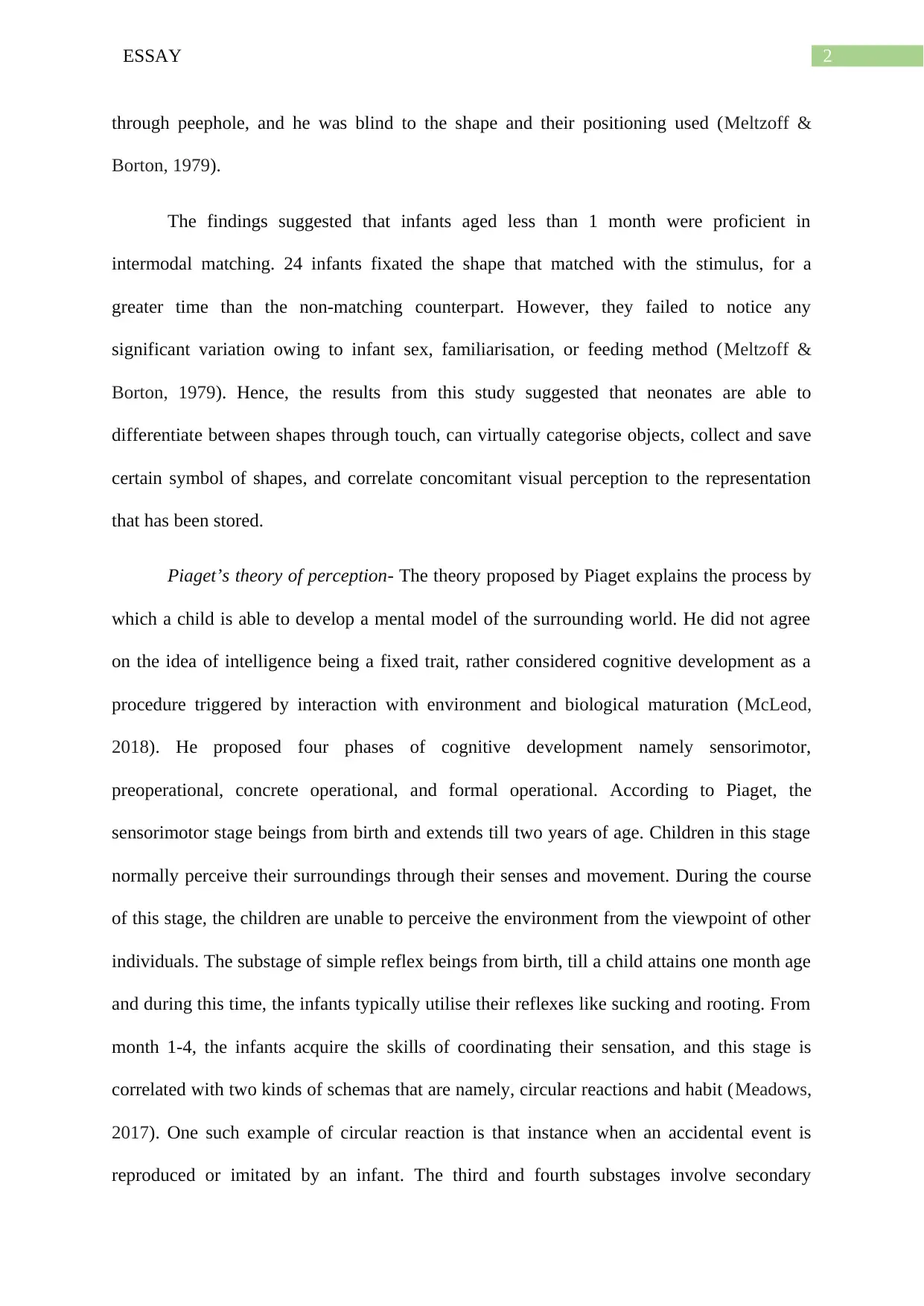
2ESSAY
through peephole, and he was blind to the shape and their positioning used (Meltzoff &
Borton, 1979).
The findings suggested that infants aged less than 1 month were proficient in
intermodal matching. 24 infants fixated the shape that matched with the stimulus, for a
greater time than the non-matching counterpart. However, they failed to notice any
significant variation owing to infant sex, familiarisation, or feeding method (Meltzoff &
Borton, 1979). Hence, the results from this study suggested that neonates are able to
differentiate between shapes through touch, can virtually categorise objects, collect and save
certain symbol of shapes, and correlate concomitant visual perception to the representation
that has been stored.
Piaget’s theory of perception- The theory proposed by Piaget explains the process by
which a child is able to develop a mental model of the surrounding world. He did not agree
on the idea of intelligence being a fixed trait, rather considered cognitive development as a
procedure triggered by interaction with environment and biological maturation (McLeod,
2018). He proposed four phases of cognitive development namely sensorimotor,
preoperational, concrete operational, and formal operational. According to Piaget, the
sensorimotor stage beings from birth and extends till two years of age. Children in this stage
normally perceive their surroundings through their senses and movement. During the course
of this stage, the children are unable to perceive the environment from the viewpoint of other
individuals. The substage of simple reflex beings from birth, till a child attains one month age
and during this time, the infants typically utilise their reflexes like sucking and rooting. From
month 1-4, the infants acquire the skills of coordinating their sensation, and this stage is
correlated with two kinds of schemas that are namely, circular reactions and habit (Meadows,
2017). One such example of circular reaction is that instance when an accidental event is
reproduced or imitated by an infant. The third and fourth substages involve secondary
through peephole, and he was blind to the shape and their positioning used (Meltzoff &
Borton, 1979).
The findings suggested that infants aged less than 1 month were proficient in
intermodal matching. 24 infants fixated the shape that matched with the stimulus, for a
greater time than the non-matching counterpart. However, they failed to notice any
significant variation owing to infant sex, familiarisation, or feeding method (Meltzoff &
Borton, 1979). Hence, the results from this study suggested that neonates are able to
differentiate between shapes through touch, can virtually categorise objects, collect and save
certain symbol of shapes, and correlate concomitant visual perception to the representation
that has been stored.
Piaget’s theory of perception- The theory proposed by Piaget explains the process by
which a child is able to develop a mental model of the surrounding world. He did not agree
on the idea of intelligence being a fixed trait, rather considered cognitive development as a
procedure triggered by interaction with environment and biological maturation (McLeod,
2018). He proposed four phases of cognitive development namely sensorimotor,
preoperational, concrete operational, and formal operational. According to Piaget, the
sensorimotor stage beings from birth and extends till two years of age. Children in this stage
normally perceive their surroundings through their senses and movement. During the course
of this stage, the children are unable to perceive the environment from the viewpoint of other
individuals. The substage of simple reflex beings from birth, till a child attains one month age
and during this time, the infants typically utilise their reflexes like sucking and rooting. From
month 1-4, the infants acquire the skills of coordinating their sensation, and this stage is
correlated with two kinds of schemas that are namely, circular reactions and habit (Meadows,
2017). One such example of circular reaction is that instance when an accidental event is
reproduced or imitated by an infant. The third and fourth substages involve secondary
⊘ This is a preview!⊘
Do you want full access?
Subscribe today to unlock all pages.

Trusted by 1+ million students worldwide
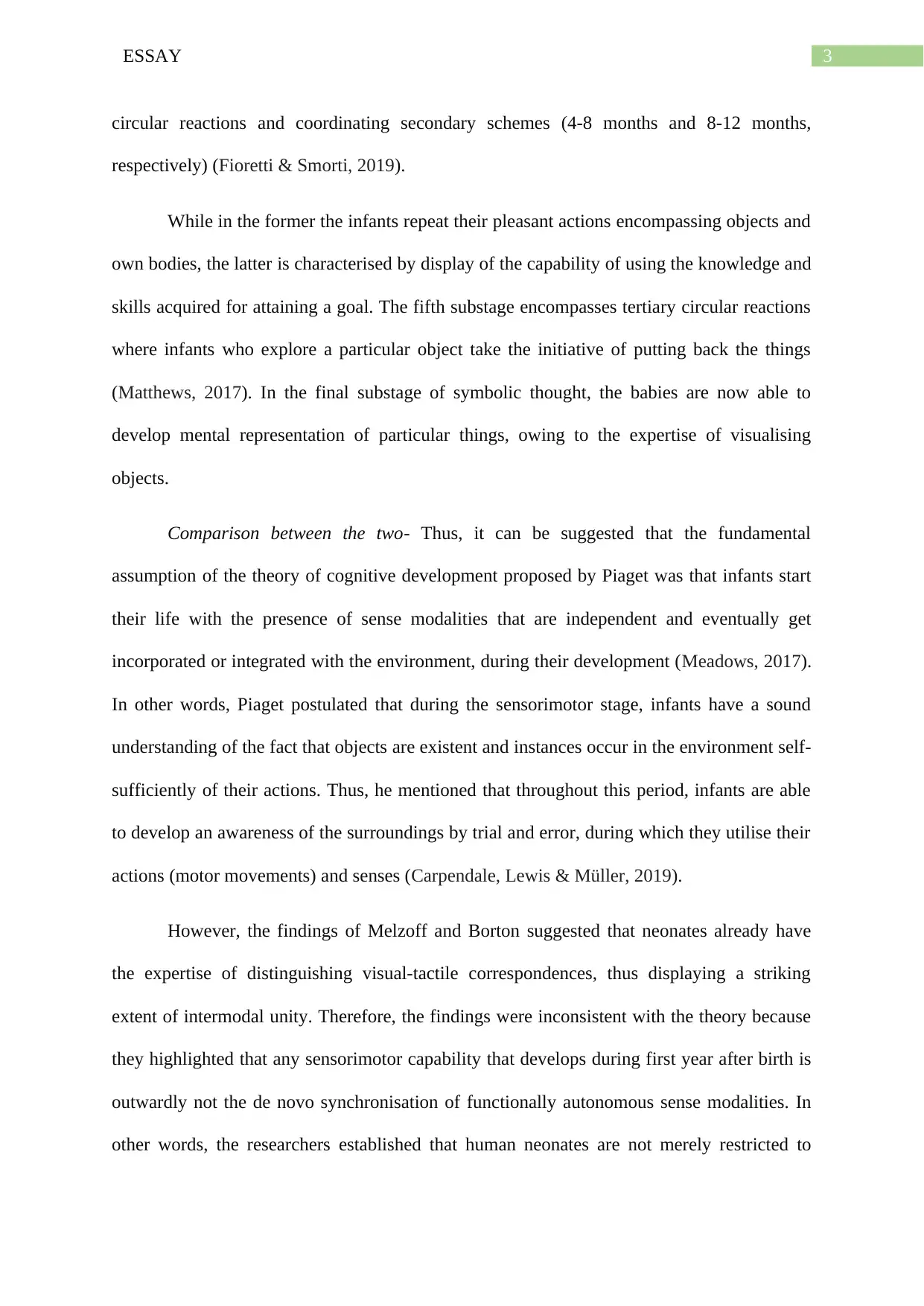
3ESSAY
circular reactions and coordinating secondary schemes (4-8 months and 8-12 months,
respectively) (Fioretti & Smorti, 2019).
While in the former the infants repeat their pleasant actions encompassing objects and
own bodies, the latter is characterised by display of the capability of using the knowledge and
skills acquired for attaining a goal. The fifth substage encompasses tertiary circular reactions
where infants who explore a particular object take the initiative of putting back the things
(Matthews, 2017). In the final substage of symbolic thought, the babies are now able to
develop mental representation of particular things, owing to the expertise of visualising
objects.
Comparison between the two- Thus, it can be suggested that the fundamental
assumption of the theory of cognitive development proposed by Piaget was that infants start
their life with the presence of sense modalities that are independent and eventually get
incorporated or integrated with the environment, during their development (Meadows, 2017).
In other words, Piaget postulated that during the sensorimotor stage, infants have a sound
understanding of the fact that objects are existent and instances occur in the environment self-
sufficiently of their actions. Thus, he mentioned that throughout this period, infants are able
to develop an awareness of the surroundings by trial and error, during which they utilise their
actions (motor movements) and senses (Carpendale, Lewis & Müller, 2019).
However, the findings of Melzoff and Borton suggested that neonates already have
the expertise of distinguishing visual-tactile correspondences, thus displaying a striking
extent of intermodal unity. Therefore, the findings were inconsistent with the theory because
they highlighted that any sensorimotor capability that develops during first year after birth is
outwardly not the de novo synchronisation of functionally autonomous sense modalities. In
other words, the researchers established that human neonates are not merely restricted to
circular reactions and coordinating secondary schemes (4-8 months and 8-12 months,
respectively) (Fioretti & Smorti, 2019).
While in the former the infants repeat their pleasant actions encompassing objects and
own bodies, the latter is characterised by display of the capability of using the knowledge and
skills acquired for attaining a goal. The fifth substage encompasses tertiary circular reactions
where infants who explore a particular object take the initiative of putting back the things
(Matthews, 2017). In the final substage of symbolic thought, the babies are now able to
develop mental representation of particular things, owing to the expertise of visualising
objects.
Comparison between the two- Thus, it can be suggested that the fundamental
assumption of the theory of cognitive development proposed by Piaget was that infants start
their life with the presence of sense modalities that are independent and eventually get
incorporated or integrated with the environment, during their development (Meadows, 2017).
In other words, Piaget postulated that during the sensorimotor stage, infants have a sound
understanding of the fact that objects are existent and instances occur in the environment self-
sufficiently of their actions. Thus, he mentioned that throughout this period, infants are able
to develop an awareness of the surroundings by trial and error, during which they utilise their
actions (motor movements) and senses (Carpendale, Lewis & Müller, 2019).
However, the findings of Melzoff and Borton suggested that neonates already have
the expertise of distinguishing visual-tactile correspondences, thus displaying a striking
extent of intermodal unity. Therefore, the findings were inconsistent with the theory because
they highlighted that any sensorimotor capability that develops during first year after birth is
outwardly not the de novo synchronisation of functionally autonomous sense modalities. In
other words, the researchers established that human neonates are not merely restricted to
Paraphrase This Document
Need a fresh take? Get an instant paraphrase of this document with our AI Paraphraser
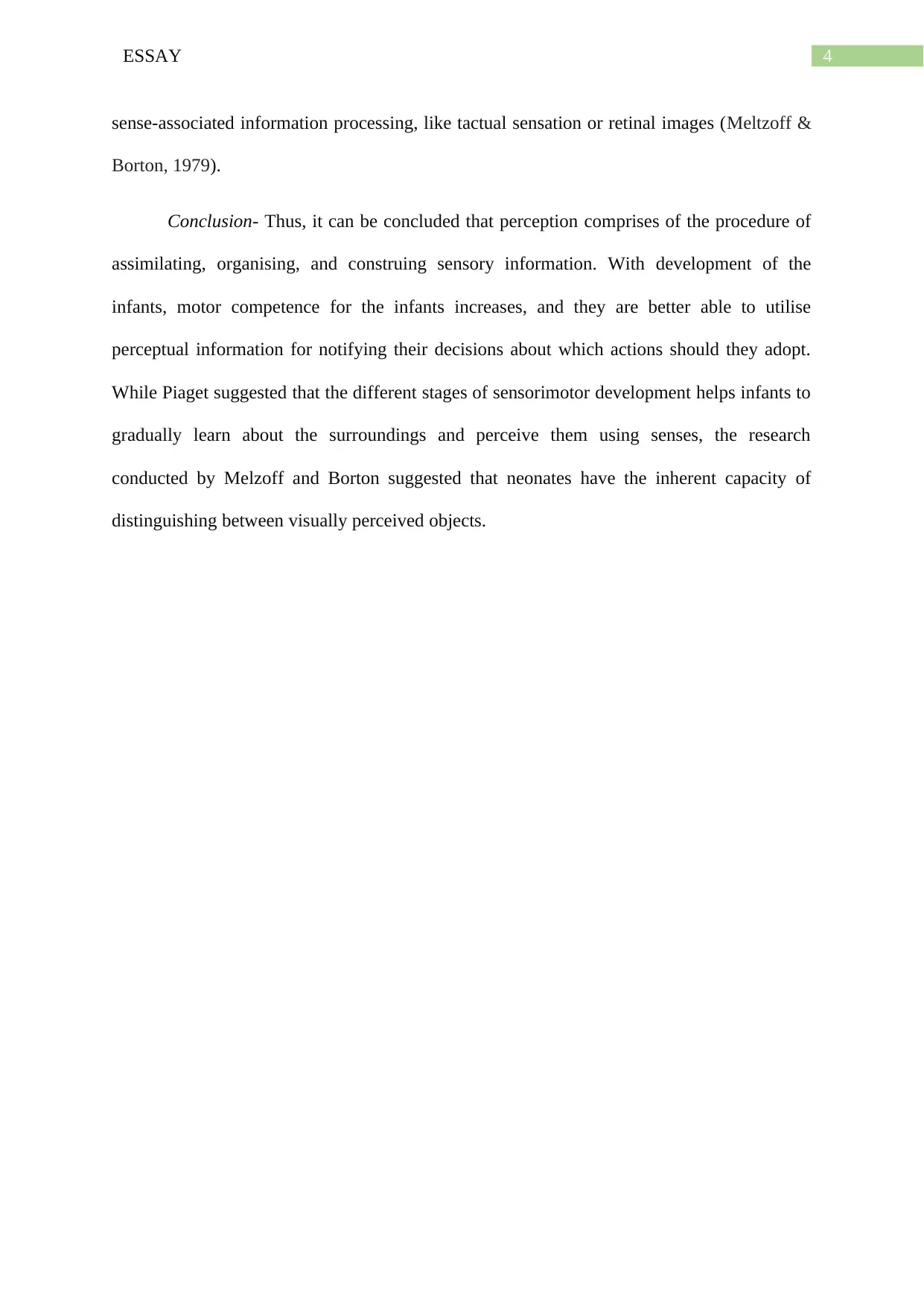
4ESSAY
sense-associated information processing, like tactual sensation or retinal images (Meltzoff &
Borton, 1979).
Conclusion- Thus, it can be concluded that perception comprises of the procedure of
assimilating, organising, and construing sensory information. With development of the
infants, motor competence for the infants increases, and they are better able to utilise
perceptual information for notifying their decisions about which actions should they adopt.
While Piaget suggested that the different stages of sensorimotor development helps infants to
gradually learn about the surroundings and perceive them using senses, the research
conducted by Melzoff and Borton suggested that neonates have the inherent capacity of
distinguishing between visually perceived objects.
sense-associated information processing, like tactual sensation or retinal images (Meltzoff &
Borton, 1979).
Conclusion- Thus, it can be concluded that perception comprises of the procedure of
assimilating, organising, and construing sensory information. With development of the
infants, motor competence for the infants increases, and they are better able to utilise
perceptual information for notifying their decisions about which actions should they adopt.
While Piaget suggested that the different stages of sensorimotor development helps infants to
gradually learn about the surroundings and perceive them using senses, the research
conducted by Melzoff and Borton suggested that neonates have the inherent capacity of
distinguishing between visually perceived objects.
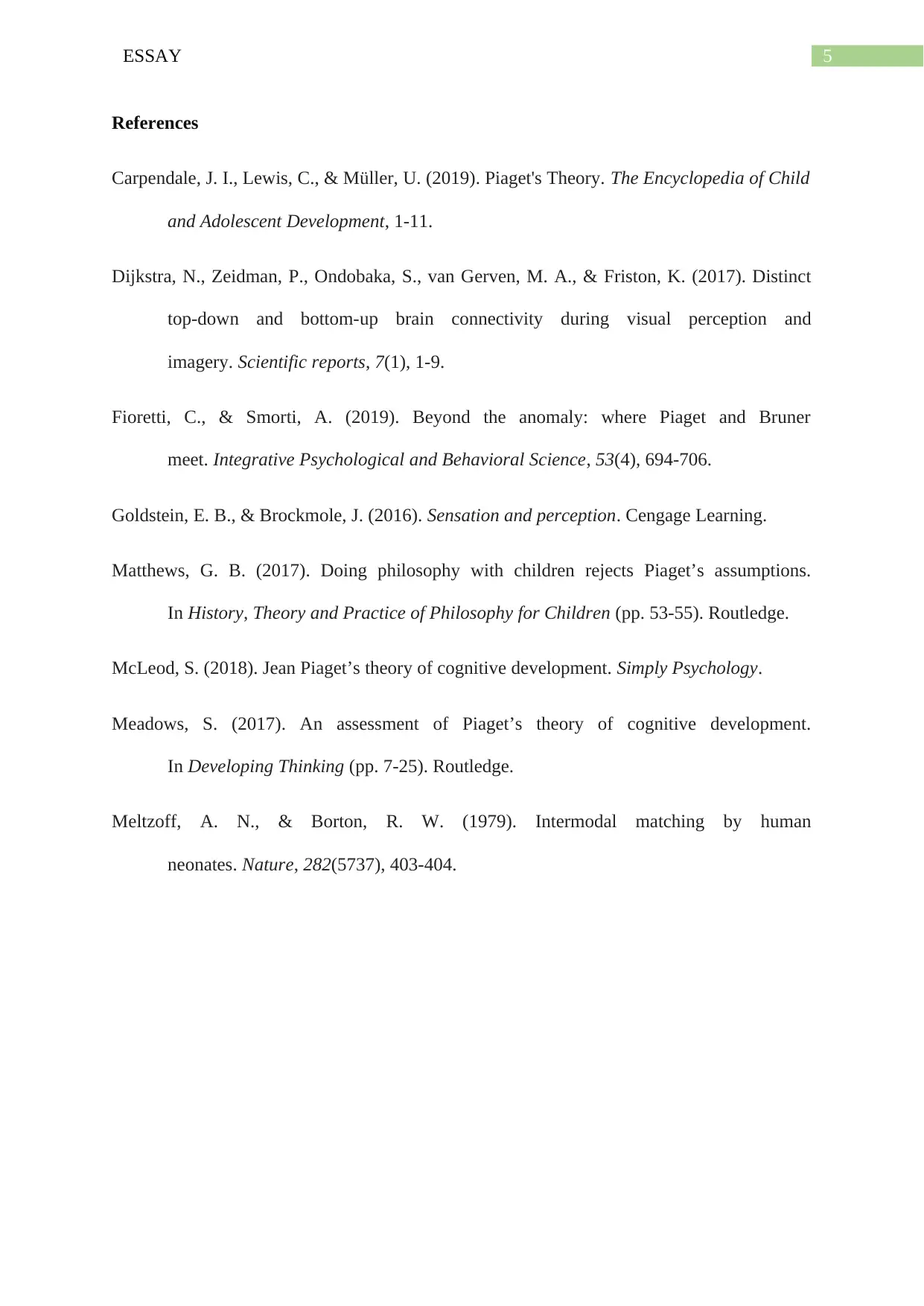
5ESSAY
References
Carpendale, J. I., Lewis, C., & Müller, U. (2019). Piaget's Theory. The Encyclopedia of Child
and Adolescent Development, 1-11.
Dijkstra, N., Zeidman, P., Ondobaka, S., van Gerven, M. A., & Friston, K. (2017). Distinct
top-down and bottom-up brain connectivity during visual perception and
imagery. Scientific reports, 7(1), 1-9.
Fioretti, C., & Smorti, A. (2019). Beyond the anomaly: where Piaget and Bruner
meet. Integrative Psychological and Behavioral Science, 53(4), 694-706.
Goldstein, E. B., & Brockmole, J. (2016). Sensation and perception. Cengage Learning.
Matthews, G. B. (2017). Doing philosophy with children rejects Piaget’s assumptions.
In History, Theory and Practice of Philosophy for Children (pp. 53-55). Routledge.
McLeod, S. (2018). Jean Piaget’s theory of cognitive development. Simply Psychology.
Meadows, S. (2017). An assessment of Piaget’s theory of cognitive development.
In Developing Thinking (pp. 7-25). Routledge.
Meltzoff, A. N., & Borton, R. W. (1979). Intermodal matching by human
neonates. Nature, 282(5737), 403-404.
References
Carpendale, J. I., Lewis, C., & Müller, U. (2019). Piaget's Theory. The Encyclopedia of Child
and Adolescent Development, 1-11.
Dijkstra, N., Zeidman, P., Ondobaka, S., van Gerven, M. A., & Friston, K. (2017). Distinct
top-down and bottom-up brain connectivity during visual perception and
imagery. Scientific reports, 7(1), 1-9.
Fioretti, C., & Smorti, A. (2019). Beyond the anomaly: where Piaget and Bruner
meet. Integrative Psychological and Behavioral Science, 53(4), 694-706.
Goldstein, E. B., & Brockmole, J. (2016). Sensation and perception. Cengage Learning.
Matthews, G. B. (2017). Doing philosophy with children rejects Piaget’s assumptions.
In History, Theory and Practice of Philosophy for Children (pp. 53-55). Routledge.
McLeod, S. (2018). Jean Piaget’s theory of cognitive development. Simply Psychology.
Meadows, S. (2017). An assessment of Piaget’s theory of cognitive development.
In Developing Thinking (pp. 7-25). Routledge.
Meltzoff, A. N., & Borton, R. W. (1979). Intermodal matching by human
neonates. Nature, 282(5737), 403-404.
⊘ This is a preview!⊘
Do you want full access?
Subscribe today to unlock all pages.

Trusted by 1+ million students worldwide
1 out of 6
Your All-in-One AI-Powered Toolkit for Academic Success.
+13062052269
info@desklib.com
Available 24*7 on WhatsApp / Email
![[object Object]](/_next/static/media/star-bottom.7253800d.svg)
Unlock your academic potential
Copyright © 2020–2025 A2Z Services. All Rights Reserved. Developed and managed by ZUCOL.